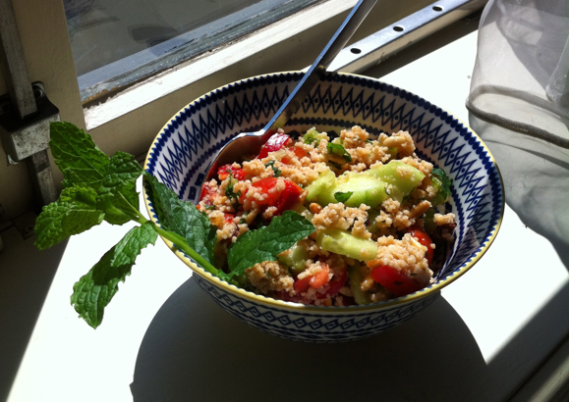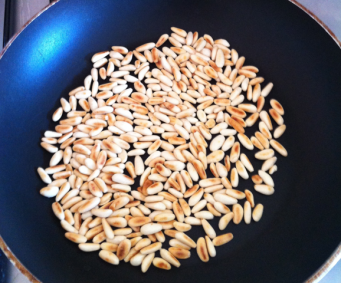This light yet satisfyingly filling dish really shines on swelteringly hot summer days where the mere thought of eating is exhausting, but makes a refreshing and healthy lunch all year round. It can be prepared in large quantities with negligible effort and feels at home in tupperware, which makes it an ideal bring-along dish for a grill party.
Source improved upon various public sources Difficulty trivial Time 30 min for preparation; benefits from an hour or two of soaking in the fridge Serves 2, but can easily be scaled to fill a large salad bowl
Ingredients
- 250 ml dry couscous
- 200–250 ml water
- 1 handful of pine nuts
- 1–2 shallots
- 1 cucumber
- 1 box of cherry tomatoes
- 2 red bell peppers
- 1 red hot chili pepper
- 1 handful of raisins
- 1 handful of pitted black olives
- 1 bunch of fresh mint sprigs
- 1 piled tsp cinnamon powder
- 1 lemon
- 1 tbsp decent olive oil
- salt and pepper
- (optional: feta, mozzarella, or halloumi)
I don’t mean to be pretentious when I say «decent» olive oil. Blindly picking a decent oil is like blindly picking a decent wine: Disregard the outrageously expensive outliers and the El Cheapo ones that come in cardboard boxes, then pick one on the upper end of the remaining price range. Or to put it in nerd speak: apply some sigma clipping, then aim for one standard deviation above the median.
Preparation
Heat the water to a boil and lightly salt it (you’ll need about ¼ teaspoon of salt). Pour in the couscous and leave it to soak. If you use the same volumes of water and couscous, the latter is going to end up very soft. If you prefer it to retain a bit of bite, you can use less water (150–200 ml or less).
Toast the pine nuts in a frying pan at high heat. You don’t need any oil; they contain enough of it already… Just give them a shake every now and then until they start to glisten and smell nice. Allow them to brown a little from several sides, then take them off the heat (best to pour them off into a bowl). Warning: If you’re doing this for the first time, keep a close watch on them and shake them frequently. They might lie around innocent and pearly white for minutes, la–la–la, until suddenly you notice their undersides have burnt black. Once the first darkish discolorations appear, things progress rather quickly. Move them a lot and relieve them from the heat in time. Dark brown spots are OK (I like them best that way), but black will taste bitter. Don’t worry, it’s not difficult; just be prepared for it.
Prepare the vegetables: Peel the cucumber and shallots; wash the tomatoes, peppers, and mint. Cut everything into small pieces. Slice the olives into rings. Soak the raisins in cold water to remove the wax coating. Some people might find raw onions a bit harsh on the stomach (or on the breath, for that matter), which may detract from the purpose of a light summer salad. We recommend soaking the chopped shallot in a cup of boiling water for a few minutes to take its edge off. (Drain the water off before using it!)
Stir the cinnamon powder through the couscous, then combine it with the vegetables and the shallot in a big salad bowl. Add the juice of the lemon and the olive oil and mix everything thoroughly. Feel free to use more oil if you don’t mind forfeiting the «light» aspect of the dish — traditional recipes certainly use a lot more oil. Finish with salt and freshly ground black pepper to taste.
At this point, the couscous is in principle ready for consumption, but it will improve greatly if you leave it to cool and soak in the fridge for an hour or two. If you’ve used a reduced amount of water for the couscous in the beginning, this will allow the lemon juice, oil, and juicy vegetables to soak into it instead.
The couscous can stand alone as a meal, but also goes well with all kinds of grilled meat. Pan-fried or grilled halloumi cheese drizzled with some lemon juice is a fantastic match and keeps it vegetarian.
Variations
This basic recipe can be adapted to your taste or kitchen inventory in innumerable ways. Adding small cubes of feta or mozzarella to the mixture is a great way of rounding out the couscous, especially if it’s meant as a stand-alone meal. You can replace the raisins with chopped dates (or use both!), add smooth-leaved parsely along with the mint, toast almond splinters rather than pine nuts, leave away the chilies if you don’t like it spicy, soak the couscous in chicken broth rather than salt water, experiment with other vegetables… feel free to be creative, as long as you come back here to report your findings! :o)



Pingback: Aglio, olio, et al. (-io) | a nerd walks into a kitchen
Pingback: Minestrone | a nerd walks into a kitchen